
Schedules are important when managing any type of project, but especially in construction. Project team members rely on the accuracy of a project schedule to help them know when and where to start work, where they will be working next, and if the project is on target to meet the completion date. We’re going to briefly look at several different types of schedules that might be used on a project, and then provide construction schedule templates you can use for many of these documents.
Construction schedule templates
Free construction schedule template
Used this to track design and building tasks on a project by duration and resource.
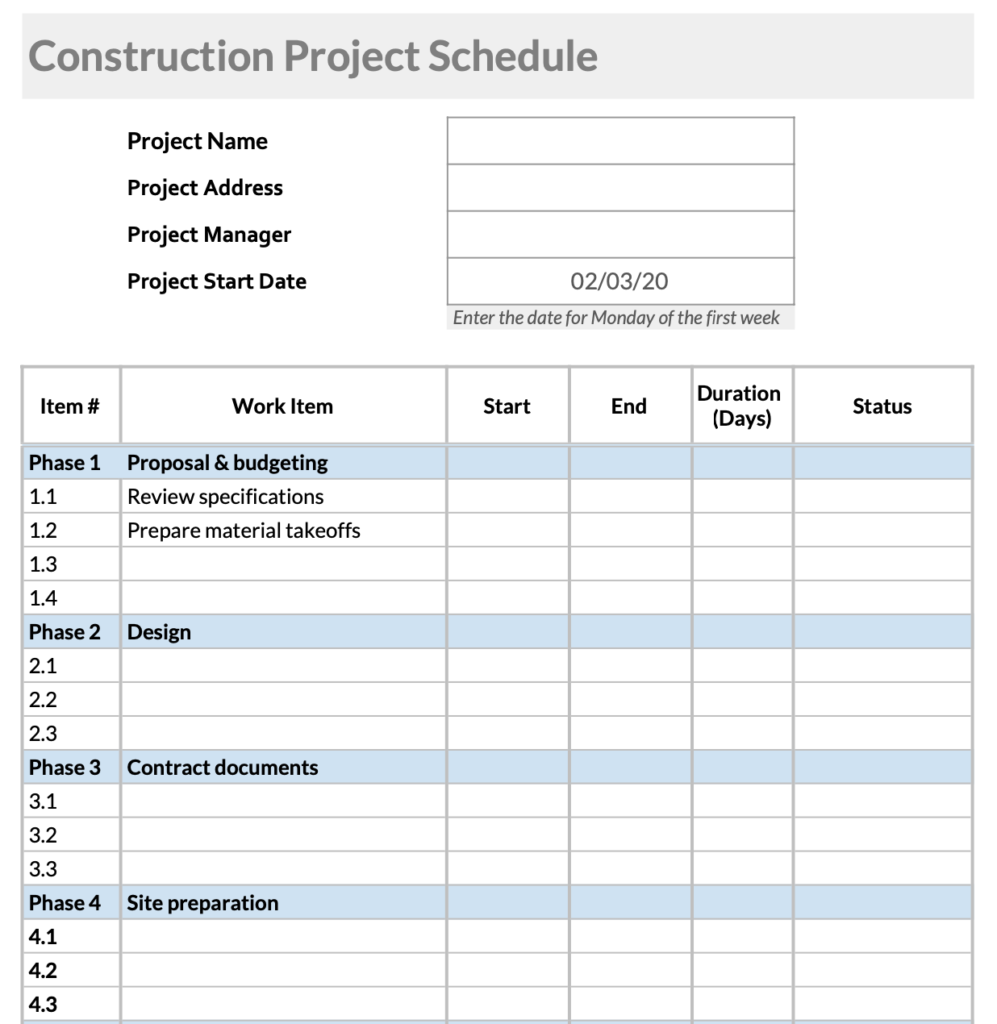
Download the template
Free schedule of values template
Use this to show the breakdown of a project by phase and contract price.
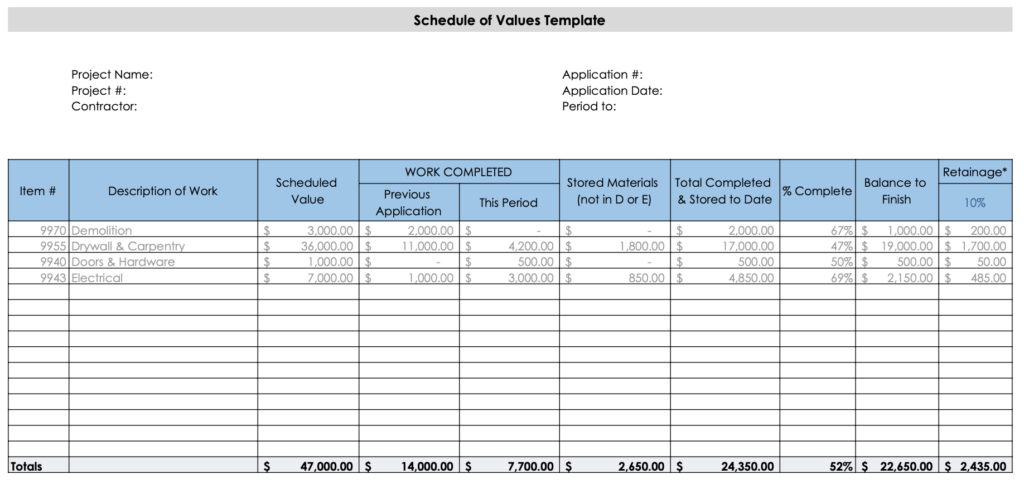
Download the template
Free payment schedule template
Use this to track the timing of costs and cash payments going out.
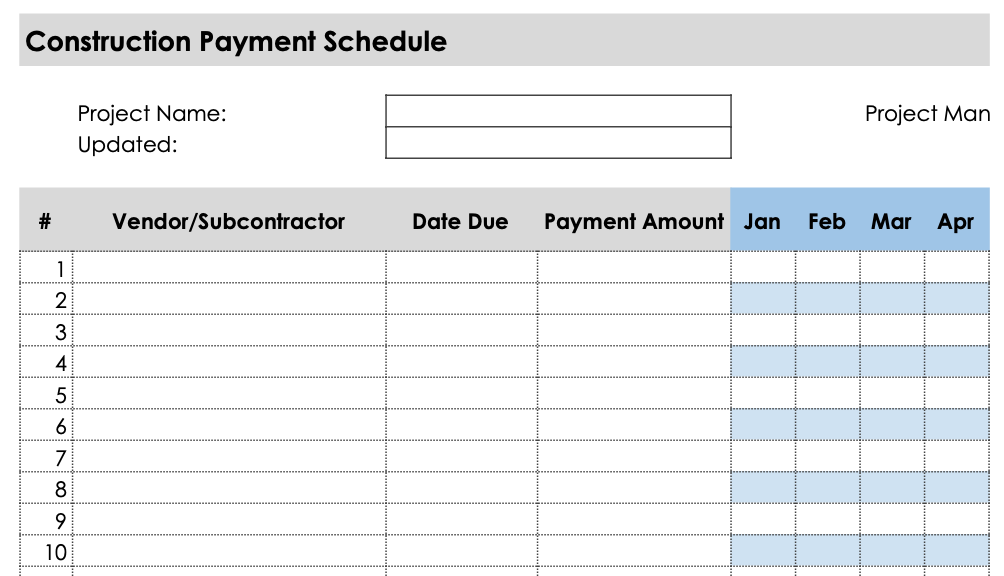
Download the template
Free draw schedule template
Use this to track the timing of income and cash payments coming in.
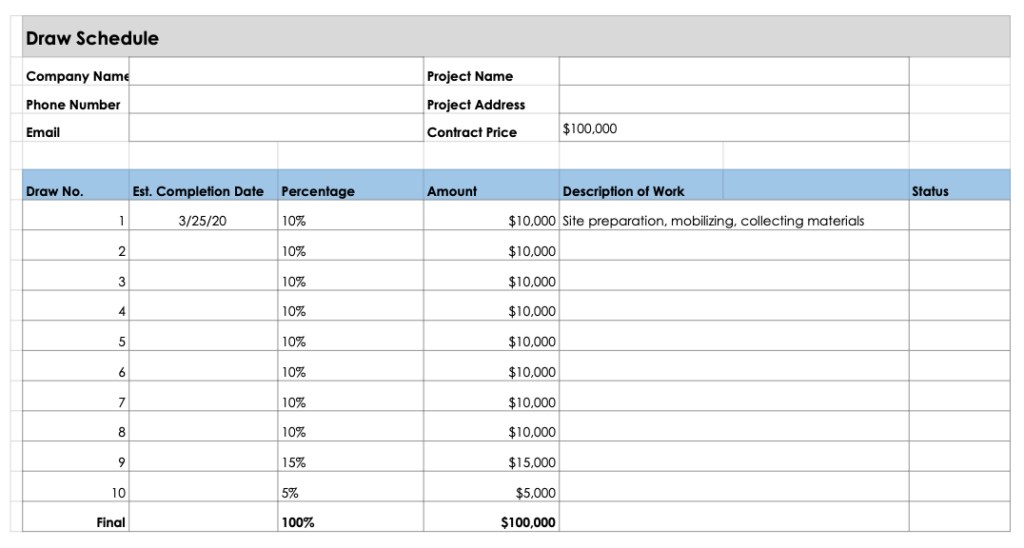
Download the template
Free submittal schedule template
Use this to track the status of submittal review.
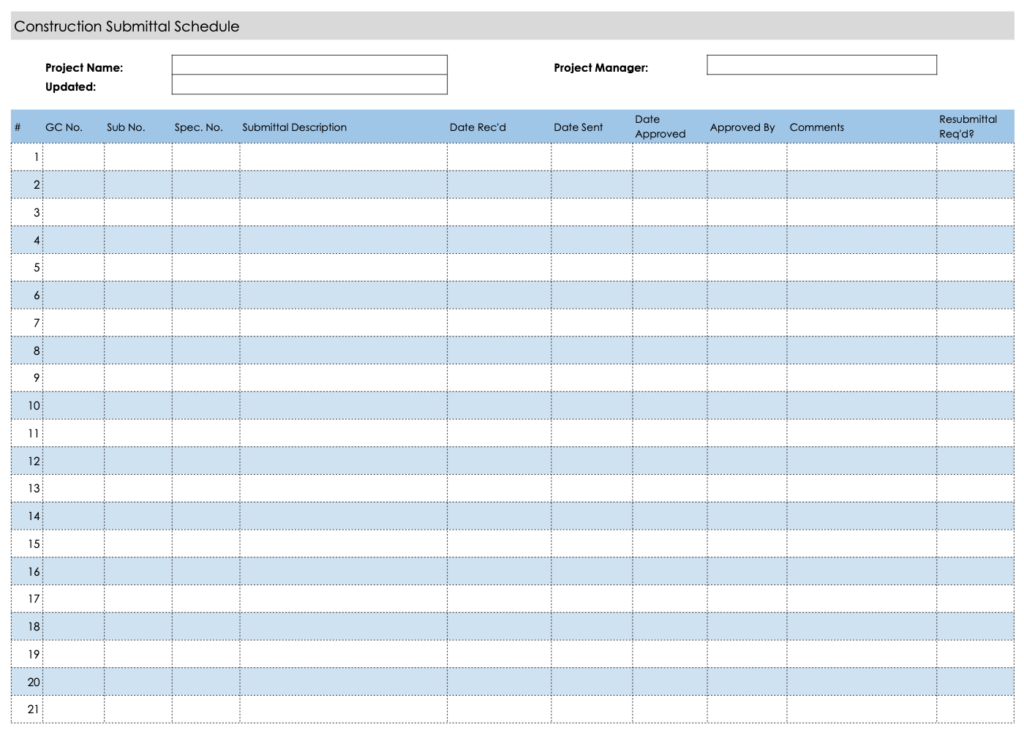
Download the template
What is a construction schedule?
A construction schedule is a timeline of each task or milestone required to complete a construction contract, and the resources needed to complete each part. Because building projects have a lot of moving parts, they often require multiple schedules, each one plotting the milestones of different departments.
Every job has a building schedule, which contains a timeline of the physical work that needs to happen, like excavation, electrical installation, and inspections. But there are also construction schedules for payments, document submittals, and labor. Each contractor and on the project probably also has a schedule that shows the timing of income and expenses over the course of the job, like a cash flow forecast.
Not having an overall project schedule can leave projects floundering. Contractors who “go with the flow” often find out too late that they’re behind schedule and they may not know how to make up the time. Having well-thought-out schedules at the beginning of a project can help contractors:
- Spot project delays sooner
- Determine their manpower needs ahead of time
- Know what tasks are critical to meeting the scheduled completion date
- Determine their cash flow needs and plan ahead
Types of construction schedules
Building schedule
The overall building schedule provides a list of the work activities or scopes that are needed and shows when each activity is scheduled to take place. There are several formats and logic methodologies that are used to develop these schedules.
A Gantt chart shows each activity as a bar on a chart, with time as the horizontal axis. Colored lines or bars are used to represent the duration of each task. This is the standard template most construction schedules use. A linked Gantt chart will show the relationships between activities. It links tasks that have to be completed before and after another certain task with lines and arrows.
The critical path method (CPM) looks at the durations, predecessors, and successors for each activity and determines how long each task can be delayed without affecting the overall completion date. Tasks that can’t be delayed at all are identified as critical path tasks. This logic helps construction teams identify these tasks so that if a delay occurs, they can make adjustments to mitigate the effect before the end of the project.
Line of balance (LOB) scheduling offers teams that are working on repetitive projects, such as roadways or tunnels, a way to schedule their resources so that the work can continue progressing. Often these projects have recurring tasks that require the same piece of equipment or crew. By taking this into account, this scheduling method ensures that each piece of equipment or crew is being used efficiently.
Q scheduling is a fairly new method of scheduling and provides teams a combination of the Gantt chart and line of balance methods. It takes into consideration both a sequence of unique activities and the resources that are needed for each task.
Schedule of values
A schedule of values provides a breakdown of the project’s phases or scopes of work and assigns each one its portion of the contract price. This schedule is generally included with payment applications as a way to show the value of the work that has been completed.
Labor schedule
A labor schedule is used by a contractor to help track their workers or crews. It involves a detailed list of the activities on a project with the type of work and the workers or crew responsible for that portion of the project. It helps contractors visualize the flow of their work on a project and also know who is working where and doing what.
Payment schedule
A payment schedule is a list of the anticipated costs on a project and when they are expected to be incurred and paid. These costs may include materials, equipment rentals, labor, and other expenses.
This schedule helps a contractor know when they expect payments to be due as the project progresses, so they can plan their cash flow accordingly.
Draw schedule
A draw schedule is similar to a payment schedule, but it anticipates how much money will be coming in and when payments will be received. It provides owners and financing companies with a projected schedule for their payments, showing how much of the project is anticipated to be complete at each draw application. This schedule can be combined with the payment schedule for a project to create a project-specific cash flow projection.
Submittal schedule
The design team and project owner need to review submittals before a project can begin. Submittals provide quality control for the project by ensuring that the specified materials and equipment are being installed.
A submittal schedule tracks all of these required documents, when they were submitted for review, the review status, and if/when they were resubmitted if necessary.
5 steps to a make a construction schedule
A schedule is only as good as long as it’s useful. There’s no secret to a successful construction schedule — the most important factor is that the people who need it
1. List all of the activities required to complete the project
Regardless of the type of schedule you’re creating, there will always be a series of events you need to complete in order to close out the job. Get as granular as you can,
2. Organize and prioritize the activities
Often, the work must be completed in a specific order. And some tasks are so critical to the overall schedule that, if it doesn’t get done, it will delay all of the other activities that come behind it.
Excavation needs to happen before the foundation can be poured. A conditional waiver may need to be sent out before the payment can be issued.
Put the activities in a logical order that makes sense for the project and
3. Communicate responsibilities and resources
Someone should be in charge of each activity, and the schedule should each responsible party for two reasons:
- The person responsible needs to knows what to do and when
- Others may need to contact the person in charge if there is a problem or delay
Additionally, it is helpful to specify the resources needed to complete each activity. For example, heavy equipment may be shared between projects. The project manager for each one should know when the backhoe needs to move from Job A to Job B.
4. Build the timeline
Add the amount of time that each activity on the schedule will take. Durations may be variable, and some scheduling software can build flexible timelines that adapts to changes on the ground.
Others, like a progress payment schedule, are generally fixed ahead of time. The contract will often specify the date that payments are made each month, so you can build out the entire project payment schedule ahead of time.
5. Share the schedule
Everyone should be working from the same schedule, so
Software for scheduling
While some contractors still prefer to do their project scheduling by hand, there are several project scheduling software packages that can help those who’d like to automate the progress. The advantage of using this kind of software is that it will run many of the analyses — like critical path or line of balance — for you, saving you a bunch of time.
It usually takes a little more time upfront to enter all the tasks and set up the proper relationships between each one, but the amount of time saved throughout the project makes up for that. Also, most programs allow you to copy schedules, so you can set up templates and use those, saving setup time.
Software for scheduling construction and labor
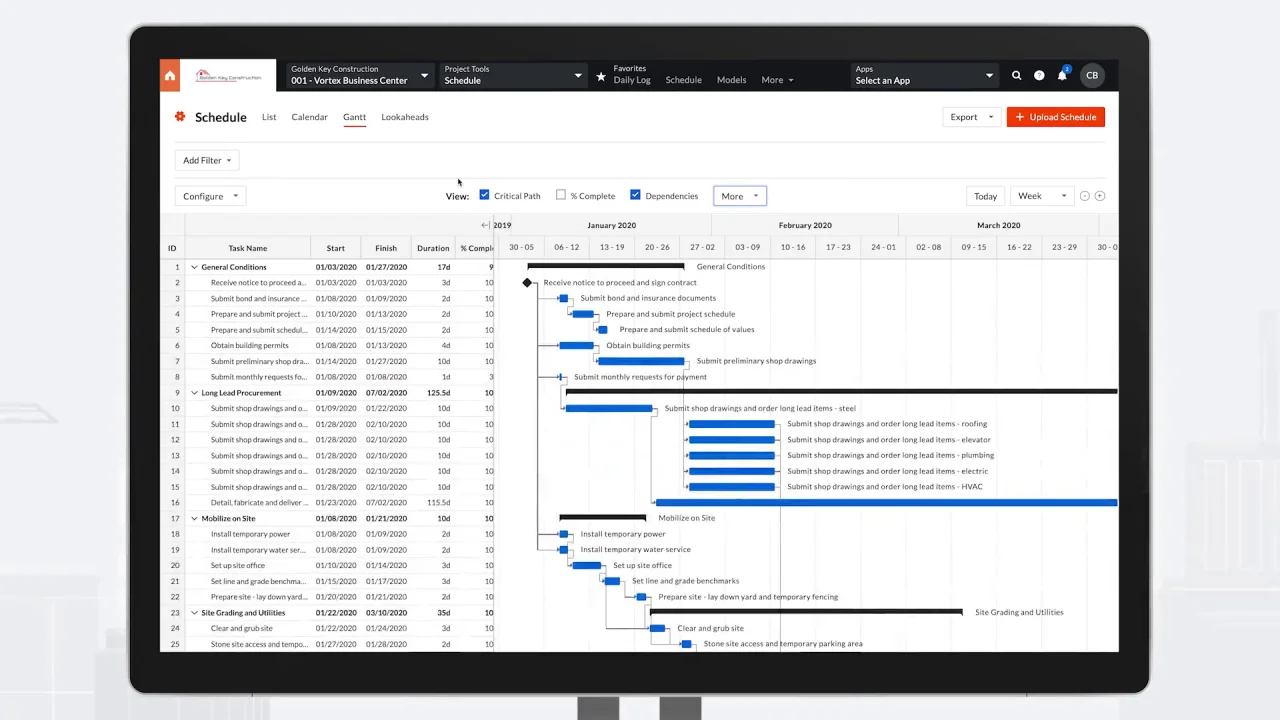
Software for scheduling payments & waivers
Software for general project schedules
There is always new software being developed — as well as integrations with other existing software programs — so keep your eye on the industry for the latest developments.
Construction schedules speed up payments
By developing a construction project schedule before a project starts, contractors can plan ahead for manpower, materials, and cash flow needs. Regularly reviewing and updating that schedule allows them to spot delays sooner so they can make plans to mitigate the effects on their cash flow. Prior planning is always easier than reacting in a crisis.
Protecting your payment rights, sending notices, and knowing your lien deadlines upfront will make the project run smoothly — and you won’t be worrying about receiving payments.